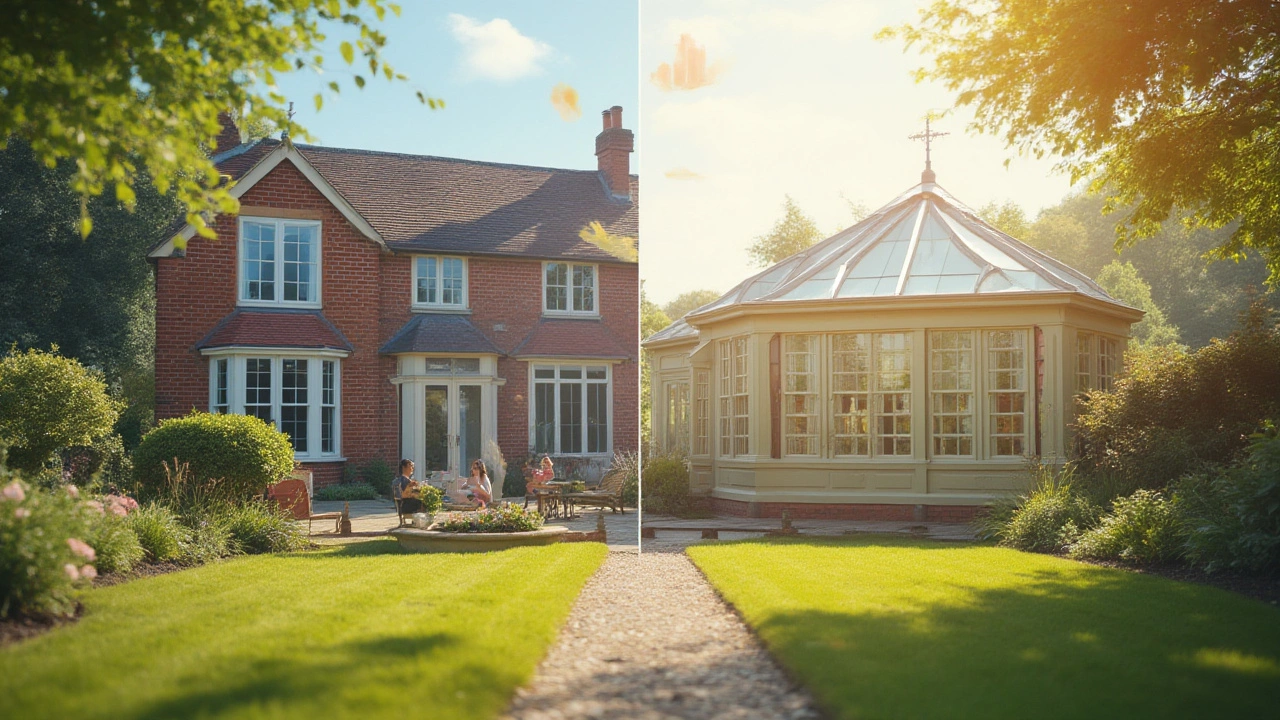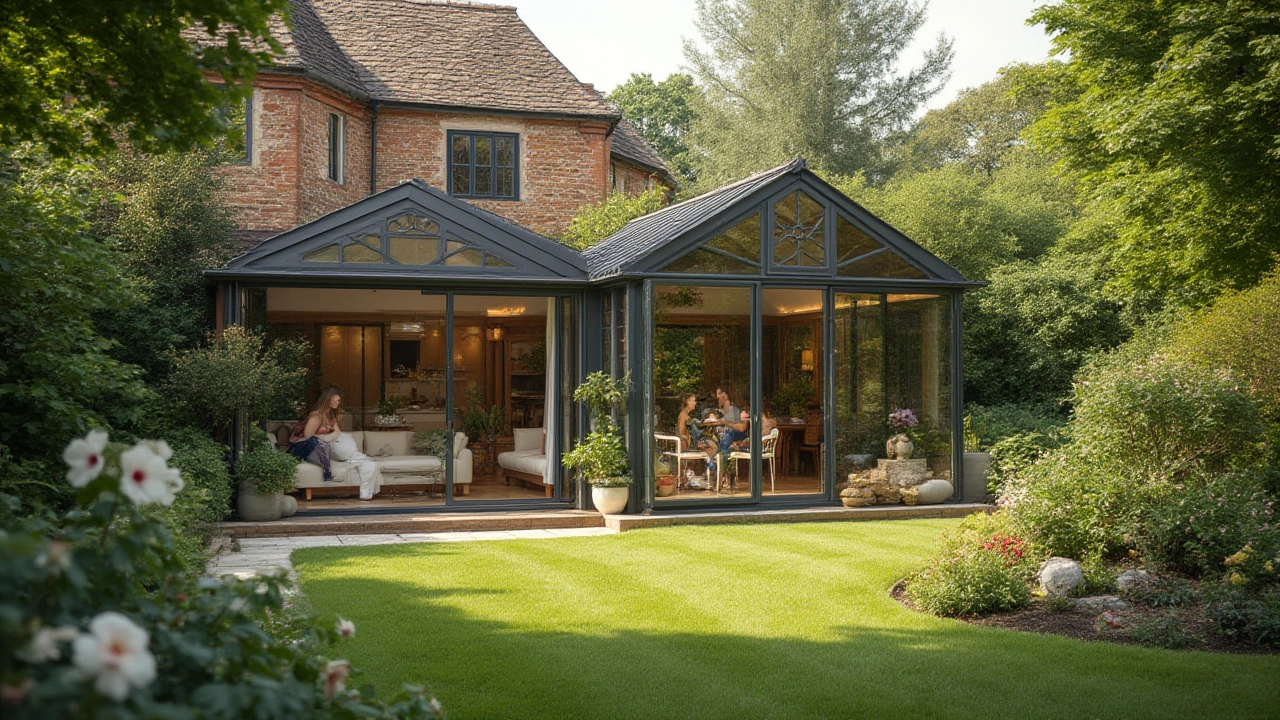Picture this: it’s mid-July, the garden is bursting with color, and you’re sitting in a room flooded with that soft, glass-filtered sunshine. Not quite a greenhouse, more refined than a standard conservatory—this is an orangery. Today, more people are eyeing these impressive extensions as not just a statement piece, but a smart home investment. But do they really live up to the hype? Let’s break down whether an orangery is truly a good investment, digging into solid numbers, lifestyle perks, and the common pitfalls most folks don’t talk about.
What Actually Is an Orangery, and How Do People Use Them?
If you’ve ever visited a stately home in Europe or spent too long scrolling dream home inspiration, you’ve probably seen an orangery. But let’s not get tangled in classic definitions. In plain terms—an orangery sits halfway between a full-on brick extension and a conservatory. You get brick or stone pillars, a solid roof (usually with a snazzy glass lantern in the center), and big windows—sometimes sliding or folding doors that practically erase the line between indoors and out.
Originally, orangeries started off as literal houses for orange trees in 17th-century France and England. These days, they’re way more versatile. People use them as garden rooms, dining spaces, home offices, or even high-end playrooms. Here’s the thing—unlike a chilly conservatory you avoid half the year, a well-built orangery is usable pretty much all year round. Modern insulation, double or triple glazing, and proper heating mean you can spend Christmas morning wrapped up in the garden view without shivering, or watch thunderstorms in July without sweating buckets.
The big difference from a classic conservatory is how solid orangeries feel. Conservatories tend to be mostly glass, and while that sounds great when you’re imagining yourself surrounded by houseplants, in the UK or anywhere with patchy seasons, they just can’t compete for comfort. An orangery’s got the bones of a proper extension, which makes them feel like a real part of the house, not just a fancy add-on.
It’s not just about the look, either. British homes are known for feeling a bit, let’s be honest, cramped. An orangery gives you extra space—a spot to eat breakfast surrounded by greenery, a place to read on rainy afternoons, or let the kids throw Lego bricks around without taking over your kitchen. I can tell you, my spouse Cora dreamed for years about ditching our dark back extension for anything remotely inviting, and once we put in the orangery, it was as if our entire downstairs shifted from “nice-enough” to “actually the heart of the home.”
But before falling in love with the vision, you’ve got to ask: is this practical? What’s the real impact on lifestyle, daily use, and how you feel about your home? Because an orangery isn’t just about the wow-factor. It’s about genuinely squeezing more joy and use out of your space—while keeping your energy bills somewhere you can live with.
If you’re wondering about actual uses, here are some real examples from UK households who had an orangery put in:
- Garden-view kitchen diners that make rushed breakfasts feel more like brunch in a countryside café.
- Remote-friendly workspaces, with tons of natural light so you don’t feel like a cave-dweller on Zoom calls.
- Entertaining friends—whether it’s winter drinks or summer BBQs, the connection to the garden wins every time.
- Plant-lovers’ paradise: plenty use orangeries as showrooms for houseplants, citrus trees, or even small indoor herb gardens. Less frost risk means less plant stress.
So what makes orangeries stand out? It’s the lifestyle bonus. But any big addition comes at a price—for your wallet and the value of your home. Let’s get to the numbers.

Real Costs, Numbers, and Value: Do Orangeries Pay Off?
We all hear whispers: “Add a posh new orangery, and your home value will skyrocket!” But is it as simple as that? Let’s take a hard look at what you’ll actually spend, the typical payback, and some less rosy truths behind the glossy brochures.
The cost of a decent orangery in the UK, as of mid-2025, lands anywhere from £30,000 to £80,000 for a medium-sized, professionally installed space. That’s a punchy investment—especially when you compare it to a basic conservatory, which you might manage for half that. The reason comes down to materials, insulation, structural engineering, and that stunning glass lantern roof. Go custom, with all the trimmings—underfloor heating, built-in lighting, custom bi-fold doors—and you’re looking at the top end, or even breaking six figures for standout builds in pricey areas.
Here’s a quick table to break down average orangery costs by size (UK, 2025 estimates):
| Size (sqm) | Budget Orangery (£) | High-spec Orangery (£) |
|---|---|---|
| 15 | 30,000 | 55,000 |
| 25 | 45,000 | 80,000 |
| 35 | 60,000 | 110,000 |
But the elephant in the orangery: does it add enough value to justify the spend? Estate agents in London and major cities often estimate that the right orangery adds somewhere between 5% and 10% to the final sale price of a house—assuming the rest of the property’s up to scratch. So, on a £400,000 home, a well-designed orangery could see your valuation bounce up by £20,000–£40,000, in the best-case scenario. Not all of the cost is covered, but you do get a hefty chunk back, and you enjoy that extra space while you live there.
But this isn’t a slam-dunk everywhere. In less pricey areas or tight terraces, pushing too high-end can lead to lower returns. If your orangery stands out like a spaceship or eats into your garden too much, you might even scare off buyers. Surveyors also look for building regulations, quality, and how well it blends with the original house. Shoddy, glass-box DIY orangeries with misty panels and bad airflow can turn into a costly eyesore faster than you’d think.
Here’s a quick data hit: Rightmove tracked listings with orangeries over a 2-year period ending this spring, and found that homes with these features spent 12% less time on market in competitive suburbs outside major UK cities. The average sale price uplift was around 8% where the orangery matched the house’s style and didn’t eat up all the outdoor space.
But what about hidden costs? Factor in planning permission (a must for most orangeries, since they’re solid structures that change your property’s footprint). Then toss in higher heating bills if it’s poorly insulated, regular cleaning for all that glass, and an occasional roofer to deal with typical British rain. Skip on ventilation or decent blinds, and you risk creating a sweltering summer sauna or a gloomy winter fridge. That said, if you splash out on good insulation and proper windows, energy running costs are often much lower than with a cheap conservatory—by about 30% on average, according to thermal efficiency tests published in 2024 by the Energy Saving Trust.
It’s not all about numbers, though. The “emotional return” shouldn’t be ignored. Families almost always say their orangery becomes the most-used, best-loved room in the house: breakfasts, games, parties, plant-watching. For plenty, the boost in happiness—and sanity—makes the whole thing worth it, even if the cash return isn’t 100%.
If you’re on the edge, here are a few pro tips for squeezing the most value:
- Match the orangery style to the house. Awkward, bolt-on designs knock value. Seamless blends with similar brick or heritage details? Potential buyers love those.
- Don’t max out your plot. Keep space for a proper garden or patio, especially if you ever want to move. Outdoor appeal = more curb appeal.
- Use experienced, well-reviewed local builders. Quality matters for buyers and for living with it long-term.
- Pile money into good glass, insulation, and heating/cooling—not just pretty trimmings. Comfort and bill savings outlast trends.
- Don’t expect an orangery to paper over deeper issues—if the rest of the house needs love, fix that first.
So—do orangeries pay off? If you want more than just square footage… quite possibly. But only if you go in with your eyes open, budget carefully, and think about daily life, not just resale value.

How to Decide: Orangery Regrets, Wins, and Deal-Breakers
Before letting glossy catalogs and Instagram rooms sweep you off your feet, get clear on the deal-breakers that turn “best home upgrade” into “never again.” People get tripped up by a few classic mistakes—some avoidable, some just bad timing. Here’s how you can dodge the biggest headaches, and ensure you actually end up with the orangery you pictured.
First: planning. The quickest route to regret is forgetting local council rules. Orangeries, being solid and changing your home’s structure, often need planning permission, especially on older homes or those in conservation areas. Skip this step, and you risk fines, expensive rebuilds, or a sale falling through years later when a solicitor checks your paperwork. My neighbor, in 2023, ended up tearing down half his orangery when planners ruled it breached height restrictions—an expensive lesson you want to avoid.
Then there’s build quality. TV shows love to feature dazzling orangery makeovers, but they never show the fiddly underbelly: how leaks sneak in around poorly sealed lanterns, or how triple-glazed bi-folds jam up after the first winter frost. Scrimp on the contractor or materials, and you’ll pay for it soon after—with hassle, stress, and cold toes in January.
Another big pitfall is expecting orangeries to solve lifestyle woes without changing habits. If everyone works from different rooms or if a chilly, dark hallway is a daily bottleneck, a new orangery won’t automatically fix it. The happiest families plan how they’ll use the space before it’s even designed—sketching out where the table, couch, and plants will go, where sockets are needed, and what it’ll feel like on a rainy Thursday as much as on sunny weekends.
On the win column, a smart orangery can flip your home’s vibe completely. Imagine sipping morning coffee watching blue tits dart around a pear tree, or the kids painting at a sunlight-filled table instead of the kitchen floor. Cora uses our orangery as an art studio, taking advantage of the wall-to-wall windows for natural light. A friend hosts bi-monthly supper clubs—a posh way of saying “pizza and plenty of wine by sunset”—all year round. These aren’t just nice-to-haves; they turn daily routines into memorable rituals, which you can’t stick a price tag on.
Personal touches pay off too. Built-in window seating stuffed with books, hidden heating for year-round comfort, or smart window shades that rise and fall with the sun’s heat. Simple upgrades can mean the difference between “nice space” and “why would we ever leave?”
So, should you take the plunge? If you’re after a low-maintenance, usable space that makes your home feel bigger, better connected to the outdoors, and a true one-off, an orangery is hard to beat. Go in with clear eyes—a realistic budget, legal ducks in a row, and the sense you’ll actually use it every week, not just at Christmas—and you’ve got a strong shot at making a comfy, valuable, and downright beautiful home improvement.
The bottom line: an orangery can easily be a worthwhile investment—but only for homeowners hungry for more than just square meters. If it blends with your house, fits your backyard, and serves up joy long before you think about selling… that’s a return worth betting on.
